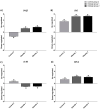Evaluation of the Effects of Diet-Induced Obesity in Zebrafish (Danio rerio): A Comparative Study
- PMID: 39408365
- PMCID: PMC11479130
- DOI: 10.3390/nu16193398
Evaluation of the Effects of Diet-Induced Obesity in Zebrafish (Danio rerio): A Comparative Study
Abstract
Objectives: This study aimed to compare diet-induced obesity (DIO) models in zebrafish and investigate the complications and differences between sexes in biochemical and inflammatory parameters.
Methods: Adult animals of both sexes were divided into four groups (n = 50) and fed for eight weeks: control group 1: Artemia sp. (15-30 mg/day/fish); control group 2: commercial fish food (3.5% of average weight); obesity group 1: pasteurized egg yolk powder + soybean oil (5% of average weight); obesity group 2: Artemia sp. (60-120 mg/day/fish). Dietary intake, caloric intake and efficiency, body mass index, biochemical, inflammatory, behavioral, histopathological, and stereological parameters, and inflammation-related gene expression were investigated.
Results: Obesity group 1 was the most indicated to investigate changes in the anxious behavioral profile (p < 0.05), triglyceride elevation [52.67 (1.2) mg/dL], adipocyte hypertrophy [67.8 (18.1) µm2; p = 0.0004], and intestinal inflammation. Obesity group 2 was interesting to investigate in terms of weight gain [167 mg; p < 0.0001), changes in fasting glucose [48.33 (4.14) mg/dL; p = 0.003), and inflammatory parameters [IL-6: 4.24 (0.18) pg/mL; p = 0.0015].
Conclusions: Furthermore, both DIO models evaluated in the present study were effective in investigating hepatic steatosis. The data also highlighted that sex influences inflammatory changes and fasting blood glucose levels, which were higher in males (p > 0.05). The results show new metabolic routes to be explored in relation to DIO in zebrafish.
Keywords: anxiety; high-fat diet; inflammation; weight gain.
Conflict of interest statement
The authors declare no conflicts of interest.
Figures















References
-
- World Obesity Atlas. [(accessed on 2 February 2023)]. Available online: https://www.worldobesity.org/resources/resource-library/world-obesity-at....
-
- Pepe R.B., Lottenberg A.M.P., Fujiwara C.T., Beyruti M., Cintra D.E., Machado R.M., Rodrigues A., Jensen N.S., Caldas A., Fernandes A.E., et al. Posicionamento Sobre o Tratamento Nutricional do Sobrepeso e da Obesidade Departamento de Nutrição da Associação Brasileira para o Estudo da Obesidade e da Síndrome Metabólica—ABESO—2022. [(accessed on 2 February 2023)]. Available online: https://abeso.org.br/wp-content/uploads/2022/11/posicionamento_2022-alte....
-
- Queiroz L.J., Medeiros I., Rosa S., Coimbra M., Camillo C.S., Paulo P., Guerra G.C.B., da Silva V.C., Schroeder H.T., Krause M., et al. Efficacy of Carotenoid-Loaded Gelatin Nanoparticles in Reducing Plasma Cytokines and Adipocyte Hypertrophy in Wistar Rats. Int. J. Mol. Sci. 2023;24:10657–10667. doi: 10.3390/ijms241310657. - DOI - PMC - PubMed
-
- Silva F.P., Araújo D., Carnier M., Paloma K.M., Valter T.B., Rischiteli A.B.S., Avila F., Pontes L.P.P., Hachul A.C.L., Neto N.I.P., et al. Low dose of Juçara pulp (Euterpe edulis Mart.) minimizes the colon inflammatory milieu promoted by hypercaloric and hyperlipidic diet in mice. J. Funct. Foods. 2021;1:104343–104353. doi: 10.1016/j.jff.2020.104343. - DOI
-
- Laranjo L., Fortes N.C.L., Santiago H.C., Marcelo V.C., Maria A.G., Moura D. Obesity-induced diet leads to weight gain, systemic metabolic alterations, adipose tissue inflammation, hepatic steatosis, and oxidative stress in gerbils (Meriones unguiculatus) PeerJ. 2017;5:2967. doi: 10.7717/peerj.2967. - DOI - PMC - PubMed
Publication types
MeSH terms
Grants and funding
LinkOut - more resources
Full Text Sources
Medical
Molecular Biology Databases

